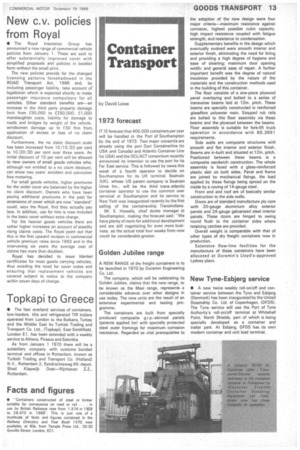Golden Jubilee range
Page 15

If you've noticed an error in this article please click here to report it so we can fix it.
A NEW RANGE of dry freight containers is to be launched in 1970 by Duramin Engineering Co. Ltd.
The company, which will be celebrating its Golden Jubilee, claims that the new range, to be known as the Maxi range, represents a considerable advance over other designs in use today. The new units are the result of an extensive experimental and testing programme.
The containers are built from specially produced composite g.r.p.-skinned panels (patents applied for) with specially protected steel outer framings for maximum corrosion resistance. Regarded as vital prerequisites to the adoption of the new design were four major criteria—maximum resistance against corrosion, highest possible cubic capacity, high impact resistance coupled with fatigue strength, and resistance to condensation.
Supplementary benefits in the design which eventually evolved were smooth interior and exterior finish, eliminating the need for lining and providing a high degree of hygiene and ease of cleaning; maximum door opening width; and general ease of repair. A further important benefit was the degree of natural insulation provided by the nature of the materials and the construction methods used in the building of this container.
The floor consists of a one-piece plywood panel overlaying and bolted to a series of transverse beams laid at 12in. pitch. These beams are specially constructed in reinforced glassfibre polyester resin. Stepped rub rails are bolted to this floor assembly via these beams and the plywood between the beams. Floor assembly is suitable for fork-lift truck operation in accordance with BS.3951 requirements.
Side was are composite structures with smooth and flat interior and exterior finish. Beams are in-built and situated at 12in. pitch. Positioned between these beams is a composite sandwich construction. The whole assembly is faced with a glass-reinforced plastic skin on both sides. Panel and frame are joined by mechanical fixings, the load applied by these fixings being spread on the inside by a coving of 14-gauge steel.
Front end and roof are of basically similar construction to the side walls.
Doors are of standard manufacture ply core with 20-gauge aluminium alloy exterior panels and 24-gauge galvanized steel interior panels. These doors are hinged to swing round flush to the container sides where retaining catches are provided.
Overall weight is comparable with that of other types of dry freight containers now in production.
Extensive flow-line facilities for the manufacture of these containers have been allocated at Duramin's Lloyd's-approved Lydney plant.












































































